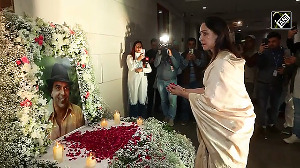The idea is to eliminate duplication among the 3 forces and to keep the overlaps in capability development to a minimum, says RS Chauhan
At the headquarters of the Integrated Defence Staff, perhaps India's only truly tri-service think-thank, there's a new focus: develop joint capabilities among the three armed forces to meet existing and emerging security threats in the next quarter century.
Leading the new initiative will be Vice Admiral DK Joshi, who took over as chief of IDS on December 31, 2010. Before replacing Air Marshal SC Mukul, Vice Adm Joshi was commander-in-chief of the tri-service Andaman and Nicobar Command.
The IDS, which came into existence after the 1999 Kargil conflict, has drawn up a 15-year 'Technology Perspective and Capability Roadmap,' identifying the key areas in which India will have to develop 'jointness' among the three services to achieve maximum synergy.
The focus, according to IDS, should be on developing/enhancing capabilities to boost: special forces, space warfare, key enablers for military diplomacy in the IOR (Indian Ocean Region), Out of Area Contingency operations, Strategic Intervention/Disaster Relief's Operations Capability and deterrence potential.
The idea, according to a strategic expert who has worked with the IDS, is: "to develop joint capabilities to ensure that an optimum balance is achieved which would provide the Indian Armed Forces and the nation the capability to shape the environment and create dependencies in our area of interest."
Accordingly, the IDS has drawn up a timeline to achieve synergy and compatibility among the three services in several key areas. For instance, the emphasis on acquiring 'Information Superiority' which encompasses the capabilities of intelligence, surveillance, target acquisition and reconnaissance (ISTAR) and command, control, communications and computers (C4) to acquire and assimilate information needed to dominate and neutralise the adversary and effectively employ own forces.
'This will require IS to include the capability for near real-time awareness of the locations and activities of both own and enemy forces throughout the battle space. It also includes a seamless, robust C4 network connecting all own forces to provide a common picture of the battle space. The capability of information warfare is also needed to affect enemy information systems while protecting one's own,' the IDS document says.
An important element in developing information superiority, according to IDS, is to develop the capability of waging electronic warfare which essentially means 'the capability to disrupt and degrade an enemy's defences and protect our own through the use of the electromagnetic spectrum including directed energy systems'.
Another focus area is area missile defence. The document says: 'Joint area missile defence is the capability to use AD (air defence) assets of the three services in conjunction with the surveillance sensors of other agencies to detect track, acquire and destroy incoming theatre ballistic and cruise missiles'.
In the post 26/11 scenario, when India's inadequacies were exposed by 10 gun-toting terrorists in Mumbai, the IDS feels there is further scope to enhance and hone the capability to launch what is called 'Military Operations in Built-Up Areas (MOBUA).'
The capability to undertake operations in built-up areas so as to achieve military objectives with minimum casualties and collateral damage includes the appropriate precision weapons as also non-lethal weapons, surveillance sensors, navigation means and communication systems that are effective in confined, built-up urban areas.
And finally, the IDS document is to develop an effective ability to counter the threats posed by the nuclear, chemical and biological warfare capability available in the neighbourhood.
'There is thus a need to provide our forces with nuclear, chemical and biological warfare defence and protection. The requirement is to enhance joint warfighting capability so that our forces are capable of operating in an NBC environment both for offensive and defensive missions,' the document says.
Experts say while the three services have their own specific doctrines to meet the future security challenges, the IDS is essentially trying to eliminate duplication and keep the overlaps in capability development to a minimum and thereby achieve synergy.
The key, however, is to translate these plans into operational capabilities in a given time.




